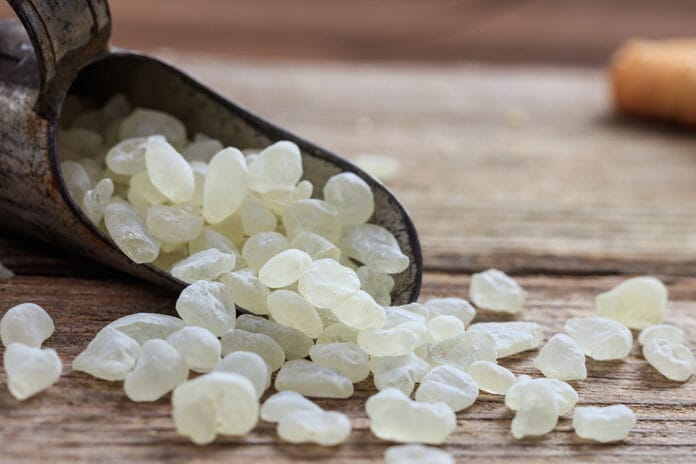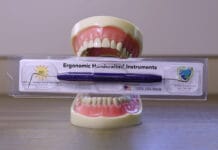Do you recommend to your patients to chew gum? Not the sugary kind like Juicy Fruit, but say gum with xylitol. Xylitol gum is wonderful at preventing decay, and some practices even supply it in their offices.1,2
When doing the research, I found an animal study as far back as 1978 showing xylitol increasing bone density. Xylitol has also been researched as an alternative for diabetic patients to consume without the spikes in blood sugar.3,4
But have you ever suggested mastic gum to patients for health and wellness, including the oral cavity benefits? I know, what the heck is mastic gum. Let us envision Greece. Turquoise waters, rose-hued sunsets, olive and almond trees, and lastly, a mastic tree. The tree is really more of an evergreen shrub that grows in the southern part of the Greek island of Chios and a few other Mediterranean countries.
A Sweet, Pleasant Resin
A resin from the tree called Chios mastic gum (CMG) is produced by the Pistacia lentiscus. The plant can be planted or replanted in other locations around the world, but it doesn’t produce the resin. Although mastic trees grow all over the Mediterranean, the special variety that grows in Chios and Cesme (a Turkish region just to the west of the Greek island) is the only one that produces natural resin or mastic.
The process takes an entire year to produce. The resin, which is called mastic, has a sweet, licorice-like flavor and a pleasant aroma. Some say the flavor is a bit bitter at first, but after some chewing, it releases a refreshing flavor similar to pine and cedar. Mastic trees live more than 100 years, almost seeming immortal. In August 2012, a wildfire destroyed more than half of the island’s mastic orchards, and the smoke could be seen through NASA’s Aqua satellite.
Mastic gum or sap-like substance comes from the tree, and you can chew it like regular gum, or there are also capsules, powder formulations, and even essential oils made from the resin. People use mastic gum for a variety of health reasons. Science provides promising evidence for the treatment of digestive and oral health conditions.
Mastic has been harvested for at least 2,500 years, and the first mention of actual mastic “tears” was by Hippocrates. Hippocrates, the “father of medicine,” used mastic for the prevention of digestive problems, colds, and as a breath freshener. “Roman emperors used mastic along with honey, pepper, and egg in the spiced wine conditum paradoxum. Digestive liqueurs, similar to Mastiha but made with grapes, were known as the Greek elixirs before the French Revolution.”5
Conditum paradoxum is an ancient honey spiced wine that is kosher for Passover and was used by the Jews of the Land of Israel. One of the oldest cookbooks in the world, Apicius, had this wine recipe as the very first recipe in the book. CMG has been used by the Greeks in cooking, cosmetics, and treating gastric illnesses. You may see it in advertising as “tears of chios,” natural “mastiha chios,” or simply “mastic gum.”
Let’s take a look at mastic gum for its dental and other whole-body health benefits.
Decay and Periodontal Disease
Could mastic gum be a natural cavity fighter? Could it help in the prevention of periodontal disease? Just after chewing mastic gum for 15 minutes, a significant decrease of total bacteria and Streptococcus mutans has been observed as well as a reduction in lactobacillus.6 As we know, higher levels of S. mutans and lactobacillus increase decay risk. The use of mastic gum for as little as three weeks has been shown to drastically reduce acidity levels within the mouth and the presence of these bacteria within the saliva.7
The Journal of Periodontology published research looking at the effects of chewing mastic gum and found it was a useful antiplaque agent that reduces bacterial growth in saliva and plaque formation on teeth.8 Finally, when comparing mastic gum at killing oral pathogens compared to chlorhexidine digluconate and hydrogen peroxide, mastic gum was the winner and was less harmful to cells and tissues.9
Antioxidant, Cholesterol, Antibacterial
The antioxidant effects of mastic have been suggested to be the mechanism by which it is able to reduce cholesterol in vitro (studies conducted on cells), in vivo (animal studies), and human studies. Researchers found that the use of mastic gum successfully reduced total cholesterol, low-density lipoprotein (LDL, the “bad” cholesterol marker), and high-density lipoprotein (HDL, the “good” cholesterol marker) levels, as well as several other biomarkers that are typically used to assess an individual’s cholesterol.10-12
Not all studies are conclusive, but data has shown mastic gum may be capable of reducing liver damage due to its anti-inflammatory effects. It had the ability to successfully reduce certain levels of liver enzymes that are damage indicators. These studies have been performed on humans (a study that has shown both the beneficial effects of mastic gum on improving cardiovascular and liver health) as well as diabetic mice, where mastic gum reduces the liver damage that is often seen in individuals who suffer from diabetes.13
Heliobacter pylori infections can cause peptic ulcers, and we also know H. pylori is a risk pathogen in periodontal disease. Mastic has been effective in the treatment of benign gastric ulcers and duodenal ulcers and in rats showed cytoprotective and mild antisecretory properties.14-16 The results of a study in the New England Journal of Medicine found that doses as low as 1mg per day inhibited bacterial growth and had definite antibacterial activity against H. pylori.17
As antibiotic resistance is becoming an important issue when tackling infections like H. Pylori, the use of natural remedies like mastic gum can make a big difference in treatment options for patients.
A 2020 review, “Traditional uses, phytochemistry and pharmacology of Chios mastic gum (Pistacia lentiscus var. Chia, Anacardiaceae): A review,” found “Chios mastic’s beneficial properties have been demonstrated in the treatment of gastrointestinal disorders, wound healing, skin inflammations, plasma lipid and blood sugar reduction and oral care.”18 This is attributed to triterpenes and volatile compounds. Terpenes consist of six isoprene units, and a terpene is basically an unsaturated hydrocarbon. Triterpenes are composed of three terpene units and in the human body is powerful and has been found as a strong anti-inflammatory and an anti-microbial to cancer and tumor reduction.19 But, as always, further research is needed.
Allergic Asthma
Any type of allergic reaction promotes inflammatory reactions, and the anti-inflammatory effects of mastic gum have been shown to reduce the inflammatory responses associated with allergic asthma. The reactions include reducing the amount of swelling present within the trachea, the presence of inflammatory cells (eosinophils) as well as hyperresponsiveness, which is a term used to describe when someone experiences an asthma attack that ultimately prevents their ability to regain control of their breathing.20
Mastic gum is not inexpensive, and be careful if it looks too good to be true ─ it probably is. Always remember that dietary supplements are not strictly regulated here in the United States, so opt for brands that have undergone independent certification through U.S. Pharmacopeia (USP), ConsumerLab, or NSF International, for example. An agricultural cooperative called Chios Mastiha Growers Association may be a good resource for authentic mastic.
The good news is that, even with the cost, the amount used may be small, which would help. For h. pylori, results have been seen with a very small dose of 1mg daily over the course of two weeks, and in 2010 research showed a dosage of 1.05 grams a day eradicated h. pylori in over a third of patients. 22,23
There are no established guidelines for the amount to chew for best results in the oral cavity. Among orthodontic patients, though, just chewing the gum for 15 minutes produced significant results in reducing the total number of bacteria.6
Make no mistake, true mastic gum can be expensive, but small amounts can do the trick! Initially, mastic is hard but will soften, turning gummy and then go from a yellow color to an opaque white and will lose its flavor just like regular gum. Of course, chewing any gum isn’t going to eliminate decay, periodontal disease, and ulcers from the planet, but it may be a helpful ally in the fight.
*Mastic gum may cause allergies in some. The mastic tree belongs to the Pistacia family of plants, which also includes the pistachio tree. Pistachio is a “close cousin” to cashew nuts.
Before you leave, check out the Today’s RDH self-study CE courses. All courses are peer-reviewed and non-sponsored to focus solely on pure education. Click here now.
Listen to the Today’s RDH Dental Hygiene Podcast Below:
References
- Janakiram, C., Deepan Kumar, C.V., Joseph, J. Xylitol in preventing dental caries: A systematic review and meta-analyses. J Nat Sci Biol Med. 2017; 8(1): 16-21. doi:10.4103/0976-9668.198344.
- Autio, J.T. Effect of xylitol chewing gum on salivary Streptococcus mutans in preschool children. ASDC J Dent Child. 2002 Jan-Apr; 69(1): 81-6, 13. PMID: 12119821.
- Mattila, P.T., Svanberg, M.J., Knuuttila, M.L. Increased bone volume and bone mineral content in xylitol-fed aged rats. Gerontology. 2001 Nov-Dec; 47(6): 300-5. doi: 10.1159/000052818. PMID: 11721142.
- Brunzell, J.D. Use of fructose, xylitol, or sorbitol as a sweetener in diabetes mellitus. Diabetes Care. 1978 Jul-Aug; 1(4): 223-30. doi: 10.2337/diacare.1.4.223. PMID: 400132.
- Chios Mastiha. (2020, December 11). Wikipedia. Retrieved from https://en.wikipedia.org/wiki/Chios_Mastiha
- Aksoy, A., et al, Short-term Effect of Mastic Gum on Salivary Concentrations of Cariogenic Bacteria in Orthodontic Patients. Angle Orthod. 2007; 77(1): 124–128. doi: https://doi.org/10.2319/122205-455R.1
- Biria, M., Eslami, G., Taghipour, E., Akbarzadeh Baghban, A. Effects of Three Mastic Gums on the Number of Mutans Streptococci, Lactobacilli and PH of the Saliva. J Dent (Tehran). 2014; 11(6): 672-679.
- Takahashi, K., Fukazawa, M., Motohira, H., Ochiai, K., Nishikawa, H. and Miyata, T. A Pilot Study on Antiplaque Effects of Mastic Chewing Gum in the Oral Cavity. Journal of Periodontology. 2003; 74: 501-505. https://doi.org/10.1902/jop.2003.74.4.501
- Koychev, S., Dommisch, H., Chen, H., Pischon, N. Antimicrobial Effects of Mastic Extract Against Oral and Periodontal Pathogens. Journal of Periodontology. 2017; 88: 511-517. https://doi.org/10.1902/jop.2017.150691
- Triantafyllou, A. et al., Chios mastic gum modulates serum biochemical parameters in a human population. Journal of Ethnopharmacology. 2007; 111(1): 43-49.
ISSN 0378-8741, https://doi.org/10.1016/j.jep.2006.10.031.
- Papada, E., Kaliora, A.C. Antioxidant and Anti-Inflammatory Properties of Mastiha: A Review of Preclinical and Clinical Studies. Antioxidants (Basel). 2019 Jul 5; 8(7): 208. doi: 10.3390/antiox8070208. PMID: 31284520; PMCID: PMC6681034.
- Kartalis, A., Didagelos, M., Georgiadis, I., et al. Effects of Chios mastic gum on cholesterol and glucose levels of healthy volunteers: A prospective, randomized, placebo-controlled, pilot study (CHIOS-MASTIHA), European Journal of Preventive Cardiology. 2016; 23(7): 722–729.
- Tzani, A., et al. Hypolipidemic, hepatoprotective and anti-inflammatory role of Chios Mastic gum in Streptozotocin-induced diabetic mice with fatty liver disease. Hellenic J Atherosc. 2016 Oct-Dec; 7(4): 161-173
- Huwez, F.U., Al-Habbal, M.J. Mastic in treatment of benign gastric ulcers. Gastroenterol Jpn. 1986; 21: 273-274.
- Al-Habbal, M.J., Al-Habbal, Z., Huwez, F.U. A double-blind controlled clinical trial of mastic and placebo in the treatment of duodenal ulcer. J Clin Exp Pharm Physiol.1984; 11: 541-544.
- Al-Said, M.S., Ageel, A.M., Parmar, N.S., Tariq, M. Evaluation of mastic, a crude drug obtained from Pistacia lentiscus for gastric and duodenal anti-ulcer activity. J Ethnopharmacol. 1986; 15: 271-278.
- Huwez, F.U., Thirlwell, D., Cockayne, A., Ala’Aldeen, D.A. Mastic gum kills Helicobacter pylori. N Engl J Med. 1998 Dec 24; 339(26): 1946. doi: 10.1056/NEJM199812243392618. PMID: 9874617.
- Akihisa. T., Nakamura, Y., Tagata, M., Tokuda, H., Yasukawa, K., Uchiyama, E., Suzuki, T., Kimura, Y. Anti-inflammatory and anti-tumor-promoting effects of triterpene acids and sterols from the fungus Ganoderma lucidum. Chem Biodivers. 2007 Feb; 4(2): 224-31. doi: 10.1002/cbdv.200790027. PMID: 17311233.
- Qiao, J., Li, A., Jin, X., Wang, J. Mastic alleviates allergic inflammation in asthmatic model mice by inhibiting recruitment of eosinophils. Am J Respir Cell Mol Biol. 2011 Jul; 45(1): 95-100. doi: 10.1165/rcmb.2010-0212OC. Epub 2010 Sep 20. PMID: 20855649.
- 20. Pachi, V.K., Mikropoulou, E.V., Gkiouvetidis, P., Siafakas, K., Argyropoulou, A., Angelis, A., Mitakou, S., Halabalaki, M. Traditional uses, phytochemistry and pharmacology of Chios mastic gum (Pistacia lentiscus var. Chia, Anacardiaceae): A review. J Ethnopharmacol. 2020 May 23; 254: 112485. doi: 10.1016/j.jep.2019.112485. Epub 2020 Feb 22. Erratum in: J Ethnopharmacol. 2021 Mar 4;273:113961. PMID: 32092498.
- Huwez, F.U., Thirlwell, D., Cockayne, A., Ala’Aldeen, D.A. Mastic gum kills Helicobacter pylori. N Eng J Med. 1998; 339(26): 1946.
- Dabos, K.J., Sfika, E., Vlatta, L.J., Giannikopoulos, G. The effect of mastic gum on Helicobacter pylori: a randomized pilot study. Phytomedicine. 2010 Mar; 17(3-4): 296-9. doi: 10.1016/j.phymed.2009.09.010. Epub 2009 Oct 29. PMID: 19879118.










